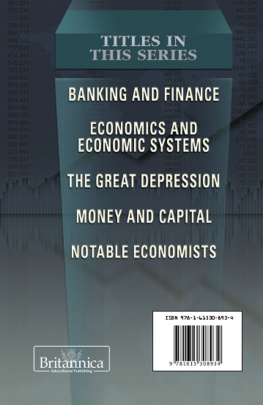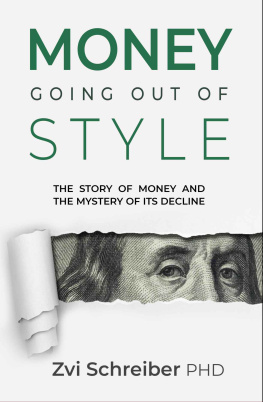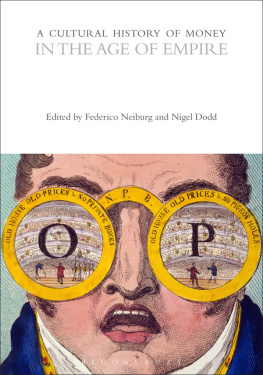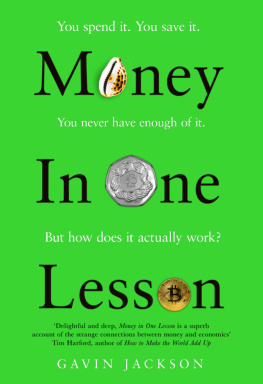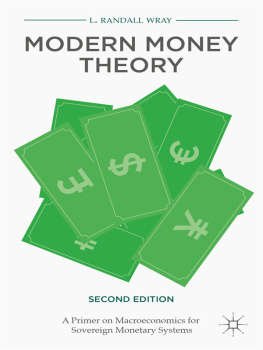
THE SOCIAL LIFE OF MONEY
THE SOCIAL LIFE OF MONEY
NIGEL DODD
PRINCETON UNIVERSITY PRESS
Princeton & Oxford
Copyright 2014 by Princeton University Press
Published by Princeton University Press,
41 William Street, Princeton, New Jersey 08540
In the United Kingdom: Princeton University Press,
6 Oxford Street, Woodstock, Oxfordshire OX20 1TW
press.princeton.edu
All Rights Reserved
Jacket design by Chris Ferrante
Library of Congress Cataloging-in-Publication Data
Dodd, Nigel, 1965
The social life of money / Nigel Dodd.
pages cm
Includes bibliographical references and index.
ISBN 978-0-691-14142-8 (hardcover : alk. paper) 1. MoneySocial aspects. I. Title.
HG221.D63 2014
332.4dc23
2014005411
British Library Cataloging-in-Publication Data is available
This book has been composed in Sabon Next LT Pro and Neutraface No. 2
Printed on acid-free paper.
Printed in the United States of America
10 9 8 7 6 5 4 3 2 1
FOR GIO
CONTENTS
ACKNOWLEDGMENTS
Numerous people have given me help, encouragement, and support while writing this book. At Princeton University Press, I have benefited greatly from the advice of Peter Dougherty and three outstanding refereesKeith Hart, Jocelyn Pixley, and Frederick Wherry. At the London School of Economics (LSE) over the years, I have enjoyed valuable conversations about the book with Bridget Hutter, Judy Wajcman, Paddy Rawlinson, Gwynne Hawkins, Matthias Benzer, Johannes Lenhard, and the late David Frisbyall superb colleagues, students, and friends. And at home, Isabella and Oscar Dodd would not forgive me if I failed to mention their advice about what to put on the cover. But my greatest debt is to my wife, Gio, who commented on multiple drafts of the book with tremendous insight and more than a little tact. Thank you all!
THE SOCIAL LIFE OF MONEY
INTRODUCTION
The people are never more fecund or more strong than on the morrow of a general bankruptcy.
PIERRE-JOSEPH PROUDHON
I know no creative person can thrive in this economy. You will lose us. I am the 99%.
OCCUPY WALLST.ORG
They have been freezing money in Greece. Between 2010 and 2012, approximately 72 billion was withdrawn from bank accounts and hidden in iceboxes, vacuum cleaners, bags of flour, pet food containers, mattresses, and under floors. The exodus of cash from bank to home, financial network to private sphere, prompted a significant rise in violent house burglary. While wealthier Greeks were investing heavily in London real estate, others were hoarding cash in more mundane domestic spaces because of what might happen to their bank accounts should Greece leave the Eurozone and launch its own independent currency. Fearful that their savings would be decimated overnight, Greeks were reversing the conventional wisdom that a bank is the most secure place to keep your money. What began as a crisis in the U.S. subprime mortgage market in 2007 was now manifesting itself as a slow-motion bank run. This problem was not confined to Greece but was happening throughout the Eurozone amid widespread doubt about the future of a project that had been launched with such optimism a little more than a decade before.
Since the collapse of Lehman Brothers in September 2008, the worlds major central banks have been plowing vast quantities of money into the banking system. The U.S. Federal Reserve has made commitments totaling some $29 trillion, lending $7 trillion to banks during the course of one single fraught week. The Bank of England has spent around 325 billion on quantitative easing alonea figure that could yet rise to 600 billionwhile the U.K. government has committed a total of 1.162 trillion to bank rescues. The European Central Bank has made low-interest loans directly to banks worth at least 1.1 trillion. These measures are not addressing the crisis alone. In April 2013, the Bank of Japan embarked on a quantitative easing program worth some $1.3 trillion, designed to end more than a decade of deflation. The social costs of the crisis, too, have been devastating. These are the costs both of the crisis itself and importantly of the policies used by governments and central banks to alleviate its effects on those very institutions that caused it. Where governments have pursued austerity programs involving significant cuts in public spending, the effect has been greatest on the weakest members of society. In the United States and the United Kingdom and in countries on the periphery of the Eurozone, people on state pensions, working for low pay or relying on social welfare, alongside those in public sector jobs such as education and health, have been hardest hit, amid rising unemployment, creeping economic stagnation, and the threat of prolonged economic recession. It seems irrefutable that societys poorest are paying for the misjudgments of its wealthiest.
The underlying causes of the crisis are deeply entrenched in the history of modern capitalism, and its immediate catalyst was located in the U.S. subprime mortgage market. These were mortgages held by the poorest borrowers, those deemed most at risk of default and charged higher rates of interest as the price of that risk. The subprime market was demographically skewed: 47 percent of Hispanic homebuyers were issued subprime-mortgage loans in 2006, compared with 26 percent of white and 53 percent of African-American homebuyers (Leigh and Huff 2007: 5). Rising interest rates drove many of these borrowers into default in 2007, triggering a credit contagion that wove a red thread of insolvency from the poorest to the richest strata of society, spreading quickly across the global financial system throughout 2008. The outcome was multiple bank failures, an economic downturn in most Western economies that may go on for some years yet, and a protracted sovereign debt crisis in the Eurozone whose economic and political consequences are likely to be profound. Central banks were under political pressure to loosen their monetary policies, and sometimes to engage in competitive currency devaluationso-called currency warsas a means of boosting exports and kick-starting economic recovery. As what some experts believe is a further consequence of the crisis, by a circuitous but discernible route, several governments collapsed amid political uprising in the Middle East The broader ramifications of the crisis for the global economy, its effect on the emerging BRIC economies (Brazil, Russia, India, and China), for example, are yet to be fully discerned.
This is a crisis of legitimacy as much as economics, provoked by the contrast between the resources that governments have devoted to rescuing banks and on the other hand, their subsequent willingness to make dramatic and socially corrosive cuts in public expenditures. Many financial institutions have been saved from insolvency by a combination of public finds and creative accounting, but households and individuals tend to be granted no such leniency. The crisis has polarized every society that has been affected by it, giving birth to a memethe 99 percentthat is inextricably tied to rising resentment and hostility toward Wall Street. Faced with these realities, it is little wonder that a war has been declared on the banking system through political protests that have embraced as wide a spectrum of society as the original crisis itself. The political rhetoric is not simply about unequal wealth and income distribution. At a more fundamental level, and in a more precise way, it attacks the financial system that is responsible for perpetuating it.
Of course, just calling this a banking crisis is too narrow a description. And to speak of banks as if they were all the sameto wit, part of an overarching Wall Street systemglosses over the complexity of financial institutions that do not operate in unison and are fragmented within themselves. Indeed, one could argue that divisions within banks, and their fragmented epistemic cultures, played a significant role in bringing the crisis about (MacKenzie 2011). Nevertheless, it is mainly the banks that have provided the conduit through which critique and protest have flowed since the crisis began. The Occupy movement is broad-based, its aims unclear, its progress uncertain. But its core thesisthat the financial system has grown absurdly disproportionate relative to the rest of the economy: distorting capitalism, widening inequality, damaging society, and exposing its key public institutions to unacceptable riskshas gained popular support across the political spectrum, on both left and right.
Next page


